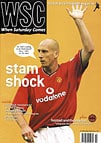 John Earls remembers the former Luton and Manchester United keeper who was a fearless cockney wide-boy
John Earls remembers the former Luton and Manchester United keeper who was a fearless cockney wide-boy
Of course, the news came as a shock. However, as anyone who saw and above all heard him in action, that Les Sealey had suffered a fatal heart attack was, unfortunately, not a total surprise. For the Manchester United defenders who played under both keepers, there would probably be some who felt that Peter Schmeichel’s roastings were lukewarm compared to Sealey yelling at them like Brian Blessed doing an Alex Ferguson impression.
But for all the pop-eyed rants, Les was not without compassion. Early in his career, the Luton defender Marvin Johnson (no stranger to own goals) sent a beautiful 40-yard half-volley over the stranded Sealey’s head into his own net against Aston Villa. Even fans at the back of the main stand at the other end of the ground cupped an ear, awaiting Les’s invective. Instead, seeing that Johnson was distraught and terrified in equal measure, Sealey opted to stay silent, turning puce from the neck up in a passable impersonation of Elmer Fudd’s rage after being outwitted again by Bugs Bunny.
Off the pitch, Sealey was equally loud, though not in such a scary way. Brought up in the East End, Sealey played the Cockney rogue to the hilt. During his heyday at Luton in the late Eighties, he was more or less the official supplier of watches and jewellery to the first team. Even David Pleat, then Luton manager, recalled after Sealey’s death that he “came in occasionally with a couple of shirts to sell”.
Sealey’s East End connections were looked on less favourably by fans of his first club, Coventry, some of whom accused him of deliberately letting in goals against West Ham in his last match for the club in 1983 – a 4-2 home defeat on the same day of Raddy Antic’s goal at Maine Road that kept Luton up. Sealey threatened to sue the local newspaper over the row and a taunting article on City’s Rivals.net website repeated the allegation after his death.
Upton Park was where Sealey ended his career, made redundant as goalkeeping coach when Glenn Roeder became manager. Only last season, Les almost got the chance to take on Old Trafford again. An injury crisis meant he was re-registered as a player at the age of 43, in case he was needed as a substitute keeper. His reaction when told he wouldn’t be needed after all was apparently one of anguish, rather than relief.
If true, it’s typical of Les’s career. After Luton and Manchester United, where he famously replaced Jim Leighton for the 1990 Cup final replay, his career gradually declined, in all honesty, until he was well past his best, via Aston Villa, West Ham, Blackpool, Leyton Orient and Bury. If Les didn’t know when to quit it’s only because, as those loud displays showed, he couldn’t understand why the other 21 players on the pitch weren’t as hyper as he was about the game.
If his name became taken for grant-ed on the team-sheets of smaller clubs, it shouldn’t be forgotten that Les’s goal-keeping was often as spectacular as his shouting. What he lacked in athleticism, he more than made up for in refusing to let strikers shoot in the first place. An old-fashioned, head-among-the-boots type of keeper, Les played 20 years too late for his natural era.
The most famous Sealey story sums up that fearlessness, captured on ITV during Man Utd’s League Cup win over Sheffield Wednesday in 1992. Sealey was the victim of a horrific tackle that, within seconds, had left his knee looking twice its natural size. Even seen on TV, the fury with which Sealey yelled at United’s physio for asking Les to be substituted was deeply worrying. Sealey stayed on, and if anyone was going to hospital that afternoon it was the physio.
It would be nice to think Les was somehow able to watch over Kenilworth Road. Better still if he could have a quiet word with our defence.
From WSC 176 October 2001. What was happening this month